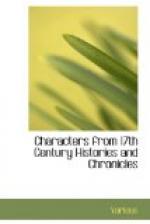l. 18. his Tuesday Sermons, likewise explained by an earlier passage in Weldon’s book, pp. 8, 9: ’the chiefe of those secrets, was that of Gowries Conspiracy, though that Nation [the Scots] gave little credit to the Story, but would speak sleightly and despitefully of it, and those of the wisest of that Nation; yet there was a weekly commemoration by the Tuesday Sermon, and an anniversary Feast, as great as it was possible, for the Kings preservation, ever on the fifth of August.’ James attempted to force the Tuesday sermon on the University of Oxford; it was to be preached by members of each college in rotation. See Brodrick’s Memorials of Merton College, 1885, p. 70.
Page 8, l. 1. a very wise man. Compare The Fortunes of Nigel, chap. v: ’the character bestowed upon him by Sully—that he was the wisest fool in Christendom’. Two volumes of the Memoires of Maximilien de Bethune, Duc de Sully (1560-1641), appeared in 1638; the others after 1650. There is much about James in the second volume, but this description of him does not appear to be there.
ll. 10-12. two Treasurers, see p. 21, ll. 15-22: three Secretaries, Sir Thomas Lake; Sir Robert Naunton; Sir George Calvert, Baron Baltimore; Sir Edward Conway, Viscount Conway: two Lord Keepers, Sir Francis Bacon; John Williams, Bishop of Lincoln (see p. 18, l. 5): two Admiralls, Charles Howard of Effingham, Earl of Nottingham; the Duke of Buckingham: three Lord chief Justices, Sir Edward Coke; Henry Montagu, Earl of Manchester; James Ley, Earl of Marlborough.
Weldon’s statement is true of the year 1623; he might have said ‘three Treasurers’ and ‘four Secretaries’.
3.
Clarendon, MS. Life, pp. 7-9, 18-20; History, Bk. I, ed. 1702, vol. i, pp. 9-11, 26-9; ed. Macray, vol. i, pp. 10-13, 38-43.
This is the first of the portraits in Clarendon’s great gallery, and it is drawn with great care. Clarendon was only a youth of twenty when Buckingham was assassinated, and he had therefore not the personal knowledge and contact to which the later portraits owe so much of their value. But he had throughout all his life been interested in the remarkable career of this ‘very extraordinary person’. Sir Henry Wotton’s ‘Observations by Way of Parallel’ on the Earl of Essex and Buckingham had suggested to him his first character study, ’The Difference and Disparity’ between them. (It is printed after the ‘Parallel’ in Reliquiae Wottonianae, and described in the third edition, 1672, as ’written by the Earl of Clarendon in his younger dayes’.) His two studies offer an interesting comparison. Many of the ideas are the same, but there is a marked difference in the precision of drawing and the ease of style. The character here reprinted was written when Clarendon had mastered his art.
Page 11, l. 5. See p. 4, l. 27.




